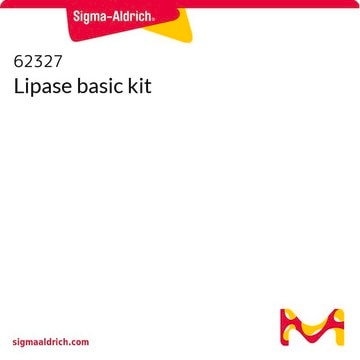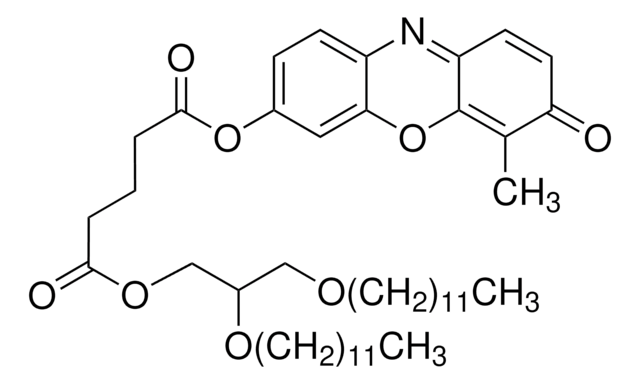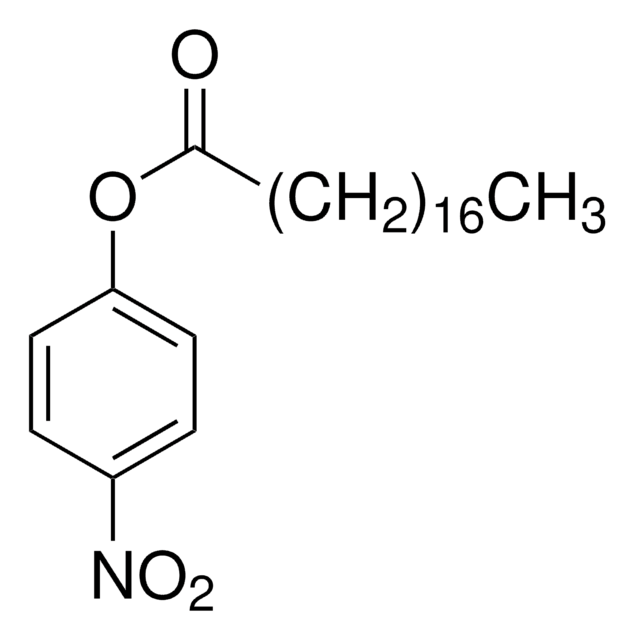MAK048
Lipase Activity Assay Kit III
sufficient for 100 fluorometric tests
Zaloguj sięWyświetlanie cen organizacyjnych i kontraktowych
About This Item
Kod UNSPSC:
12161503
NACRES:
NA.84
Polecane produkty
zastosowanie
sufficient for 100 fluorometric tests
metoda wykrywania
fluorometric
temp. przechowywania
−20°C
Opis ogólny
The lipase family of enzymes catalyzes the cleavage of the ester bonds of lipids. In mammals, this family includes many critical members including pancreatic, hepatic, endothelial, and lipoprotein lipase. Lipases, such as pancreatic lipase, are critical for the metabolism of lipids. Lipases also play key roles in processes such as cell signaling and inflammation. Measurements of lipase activity are commonly used to screen for pancreatic injury or disease, and to monitor diseases such as cystic fibrosis, celiac disease, and Crohn′s disease.
Zastosowanie
- High-Temperature Short-Time and Holder Pasteurization of Donor Milk: Impact on Milk Composition.: This study evaluates the effects of different pasteurization methods on the composition of donor milk, focusing on its nutritional and biochemical properties (Escuder-Vieco et al., 2021).
Cechy i korzyści
Compatible with high-throughput handling systems.
Przydatność
Suitable for the detection of lipase activity in biological samples including tissue, cells and serum
Zasada
The Lipase Activity Assay Kit III provides a simple and direct procedure for measuring lipase activity in a variety of samples. Lipase activity is determined using a coupled enzyme reaction, which results in the generation of methylresorufin (λex = 529/λem = 600 nm) proportional to the enzymatic activity present. One unit of lipase is the amount of enzyme that will generate 1.0 μmole of methylresorufin from the substrate per minute at 37 °C.
This page may contain text that has been machine translated.
Hasło ostrzegawcze
Danger
Zwroty wskazujące rodzaj zagrożenia
Zwroty wskazujące środki ostrożności
Klasyfikacja zagrożeń
Resp. Sens. 1
Kod klasy składowania
10 - Combustible liquids
Certyfikaty analizy (CoA)
Poszukaj Certyfikaty analizy (CoA), wpisując numer partii/serii produktów. Numery serii i partii można znaleźć na etykiecie produktu po słowach „seria” lub „partia”.
Masz już ten produkt?
Dokumenty związane z niedawno zakupionymi produktami zostały zamieszczone w Bibliotece dokumentów.
Klienci oglądali również te produkty
Varsha Patil et al.
Frontiers in microbiology, 12, 722229-722229 (2021-09-21)
Mycobacteria such as Mycobacterium tuberculosis, the causative agent of tuberculosis that annually kills several million people worldwide, and Mycobacterium smegmatis, the non-pathogenic fast-growing mycobacteria, require oxidative phosphorylation to meet their energy requirements. We have previously shown that deletion of one
Raymond Rubianto Tjandrawinata et al.
Frontiers in microbiology, 13, 825251-825251 (2022-03-18)
The anti-hypercholesterolemic effect of 11 Lactobacillus isolates was investigated in vitro by measuring remaining cholesterol in growth media, growth ability in media supplemented with cholesterol, and BSH activity. Among the selected isolates, DLBSH104, DLBSH122, and DLBSK207 have demonstrated outstanding potential
Lin Zhu et al.
Diabetes, 67(12), 2494-2506 (2018-09-15)
In clinical trials, inhibition of cholesteryl ester transfer protein (CETP) raises HDL cholesterol levels but does not robustly improve cardiovascular outcomes. Approximately two-thirds of trial participants are obese. Lower plasma CETP activity is associated with increased cardiovascular risk in human
Nasz zespół naukowców ma doświadczenie we wszystkich obszarach badań, w tym w naukach przyrodniczych, materiałoznawstwie, syntezie chemicznej, chromatografii, analityce i wielu innych dziedzinach.
Skontaktuj się z zespołem ds. pomocy technicznej








